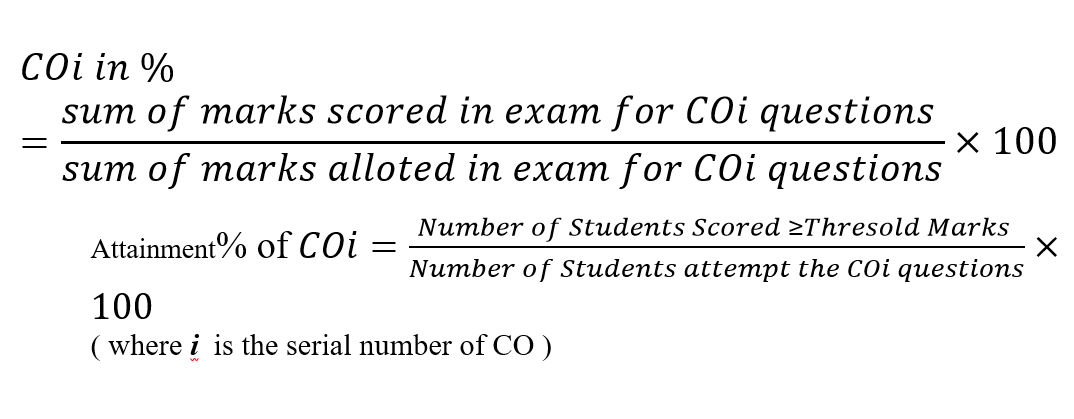Annual Quality Assurance Report(AQAR) - 2021-2022
|
Metric No. |
2.6 Student Performance and Learning Outcome |
|||||||||||||||||||||||||||||||||||||||||||||||||||||||||||||||||||||||||||||||||||||||||||||||||||||||||||||||||||||||||||||||||||||||||||||||||||||||||||||||||||||||||||||||||||||||||||||||||||||||||||||||||||||||||||||||||||||||||||||||||||||||||||||||||||||||||||||||||||||||||||||||||||||||||||||||||||||||||||||||||||||||||||||||||||||||||||||||||||||||||||||||||||||||||||||||||||||||||||||||||||||||||||||||||||||||||||||||||||||||||||
|
2.6.1. QlM |
Programme Outcomes and Course Outcomes for all Programmes offered by the institution are stated and displayed on the website and communicated to teachers and students: Program Outcomes (POs), Program Specific Outcomes (PSOs), and Course Outcomes (COs) are framed by the department following extensive consultation with all faculty and stakeholders, in strict conformity with the objectives of Outcome Based Education (OBE). Following the achievement of consensus, the information is extensively disseminated and popularized via various methods described below. ● Website ● Department Notice Boards ● Meetings with employers ● Laboratories ● Library ● Induction Programs ● Faculty meetings ● Parent meet ● Alumni meetings The HODs along with the faculty members provide information to students, raise awareness, and stress the importance of achieving the goals. Specified skill requirements to be met by students at the micro level and by the end of the programme known as PSOs. The PSOs are normally prepared by the programme coordinators in cooperation with course coordinators. The BOS of each department, will discuss and approve the proposal after approval by the Principal. Link for relevant documents: Link for the PO, PSO & PEO (Electronics & Communication Engineering Department): Link for thePO, PSO & PEO(Electrical & Electronics Engineering Department): https://drive.google.com/file/d/1ym0_HRB1yPKSerbshQUhN0FaLJdUE7gN/view?usp=sharing Link for the PO, PSO & PEO(Computer Engineering Department): Link for syllabus for Autonomous batch(Computer Engineering Department Batch 2020-2024): Link for syllabus for Autonomous batch(Computer Engineering Department Batch 2019-2023) Link for syllabus Makaut batch (Computer Engineering Department):
|
|||||||||||||||||||||||||||||||||||||||||||||||||||||||||||||||||||||||||||||||||||||||||||||||||||||||||||||||||||||||||||||||||||||||||||||||||||||||||||||||||||||||||||||||||||||||||||||||||||||||||||||||||||||||||||||||||||||||||||||||||||||||||||||||||||||||||||||||||||||||||||||||||||||||||||||||||||||||||||||||||||||||||||||||||||||||||||||||||||||||||||||||||||||||||||||||||||||||||||||||||||||||||||||||||||||||||||||||||||||||||||
|
2.6.2.
QlM |
Attainment of Programme Outcomes and Course Outcomes as evaluated by the institution: Each course contains a set of COs and evaluation criteria that must be met. The course results are mapped to the POs. Through the mapping of questions to COs and COs to POs and PSOs, the students’ performance on examinations over the semester in each course is utilized to compute the level of achievement of the POs and PSOs The process of course outcome assessment is by direct or indirect method. The direct method consists of Mid Examinations and Semester End Examination. The indirect assessment is done through the course end survey. Rubrics are framed for the assessments. The attainment of each CO is computed by setting the class average mark as the target. The COs of each course are mapped to POs & PSOs with weightages of 3 (Strong), 2 (Medium) and 1 (Weak). Assessment of CO of courses A course result should satisfy at least one or more of the program’s outcomes. These are the abilities, knowledge that students can display after course completion. CO attainment is calculated using the percentage of pupils who score over 80% in each measured criterion. Attainment of PO and PSO All of the courses that contribute to the PO are recognized, and are assessed using both direct and indirect assessments through the COs. The degree of achievement of each CO is compared to the specified targets for each course, and if they are not met, faculty offers ways to improve it.
Table: 1.1
Defining relation between Course Outcomes (COs) and POs for each course to obtain overall CO mapping with each POs.Defining relation between Course Outcomes (COs) and POs for each course to obtain overall CO mapping with each POs – In this step, COs of each course are mapped with POs. The CO levels corresponding to each PO are averaged to obtain overall CO level for each PO and this is repeated for all courses.Example: Obtaining overall CO level with each PO for the course PCCCS501
Table: 2The last row of the above table is showing the corresponding overall CO levels with each PO for PCCCS501. Development of overall CO-PO mapping matrix for all courses. The overall CO levels will be obtained for all courses from the CO-PO mapping table of each course (Table 2) and can be expressed in matrix form. Each element of the matrix can be expressed as 𝐶𝑂𝑃𝑂𝑖, where 𝑖 denotes serial number of a course and 𝑗 corresponds 𝑗th PO. Example: A part of the CO/PO mapping matrix is given below
Table: 3From the above matrix, the bottom right element can be written as 𝐶𝑂𝑃𝑂Nth,12 Course Outcome (CO) Attainment Process: The attainment of COs are evaluated using the existing student data from the examination results, quizzes and laboratory sessions for a course.
CO Attainment value is evaluated using the formula given below.
According to the formula those students are considered only who have scored greater than/equal to the 60 % of marks assigned for a particular question. ● Computation and construction of overall CO attainment matrix for each course using course assessment tools.The assessment tools for CO attainment of the courses are minor exams, major exam and continuous assessment. The CO attainment levels for each method of assessment are defined below: Continuous Assessment(CA) based on class attendance & assignment2
Table: 4
Course attainment levels through End Semester Examination (E𝑖) , Mid Semester Examination (𝑀𝑖) and Continuous Assessment(CA𝑖) assessment method for 𝑖th course are obtained using the above table and method-wise marks obtained by students in a course. Overall Course Outcome (OCO) attainment level for each course is given by 𝑂𝐶𝑂𝑖=0.7×E𝑖+ 0.2×𝑀𝑖 + + 0.1×CA𝑖 ( i is the serial number of a course.) Where E𝑖 and M𝑖 represent CO attainment levels using End Semester, Mid Semester assessment methods respectively. Example: Overall CO attainment level for a course
Table : 4.2Overall CO attainment level of PCCCS 501𝑂𝐶𝑂1 = 𝟎.7×𝟑 + 𝟎.2×𝟐+ 𝟎.1×3=2.80( 1 is the serial number of the course. PCCCS 501)Attainment of PO through CO-PO mapping: Attainment of each PO is calculated using the mapping of respective CO to PO/s and the attainment of each CO using the following equation.
(Where i is the serial number of PO ranges from 1 to 12)
●Calculation and construction of Direct PO attainment matrix using overall CO-PO mapping matrix and overall CO attainment matrix. The direct PO attainment of a course is given by 𝐷𝐶𝑃𝑂𝑖,=𝐶𝑂𝑃𝑂𝑖,𝑘×1/3 𝑂𝐶𝑂𝑖 Where 𝑖 is the serial number of a course, 𝑘 corresponds to 𝑘th PO. ,and 𝑂𝐶𝑂𝑖 can be obtained from Table: 3 and Table: 4 with formulae respectively for each course.
Indirect assessment is done through program student survey, alumni survey and employer survey. Program student’s survey is given a weight age of 40%, employer and alumni survey are given a weight age of 30% each. Survey forms were prepared (hard copy and Google form) and distributed among current students, graduating students, alumni and employers. Feedback forms were designed with questions corresponding to POs and PSOs relevant to the program. All the feedback forms are collected and data are tabulated in an excel sheet. Average level for each PO has been calculated using the formula
Where 𝑝 is the number of current student participants, 𝑞 is the number of alumni participants, 𝑟 is the number of employer participants, 𝑗 is the number of PO related questions and 𝑄𝑃𝑂𝑗, is the level given by 𝑝th participant for 𝑗th question. 𝐼𝑃𝑂𝑗 is the indirect attainment of 𝑗th PO.
The formula for calculating overall PO attainment is given by 𝑂𝑃𝑂𝑗=0.8×𝐷𝑃𝑂𝑗+0.2×𝐼𝑃𝑂𝑗, where 𝑗=1…12 (12 POs).
In this step the target levels of PO attainment which were obtained are compared with the attainment computed.
Example:
|
|||||||||||||||||||||||||||||||||||||||||||||||||||||||||||||||||||||||||||||||||||||||||||||||||||||||||||||||||||||||||||||||||||||||||||||||||||||||||||||||||||||||||||||||||||||||||||||||||||||||||||||||||||||||||||||||||||||||||||||||||||||||||||||||||||||||||||||||||||||||||||||||||||||||||||||||||||||||||||||||||||||||||||||||||||||||||||||||||||||||||||||||||||||||||||||||||||||||||||||||||||||||||||||||||||||||||||||||||||||||||||
|
2.6.3.
QnM |
Pass Percentage of students: 2.6.3.1: Total number of final year students who passed in the examinations conducted by Institution:
2.6.3.2: Total number of final year students who appeared for the examinations
Link of supporting documents:
|
|||||||||||||||||||||||||||||||||||||||||||||||||||||||||||||||||||||||||||||||||||||||||||||||||||||||||||||||||||||||||||||||||||||||||||||||||||||||||||||||||||||||||||||||||||||||||||||||||||||||||||||||||||||||||||||||||||||||||||||||||||||||||||||||||||||||||||||||||||||||||||||||||||||||||||||||||||||||||||||||||||||||||||||||||||||||||||||||||||||||||||||||||||||||||||||||||||||||||||||||||||||||||||||||||||||||||||||||||||||||||||





